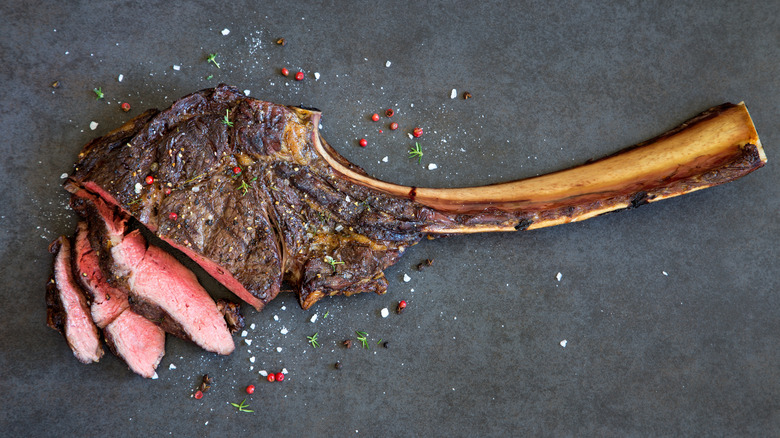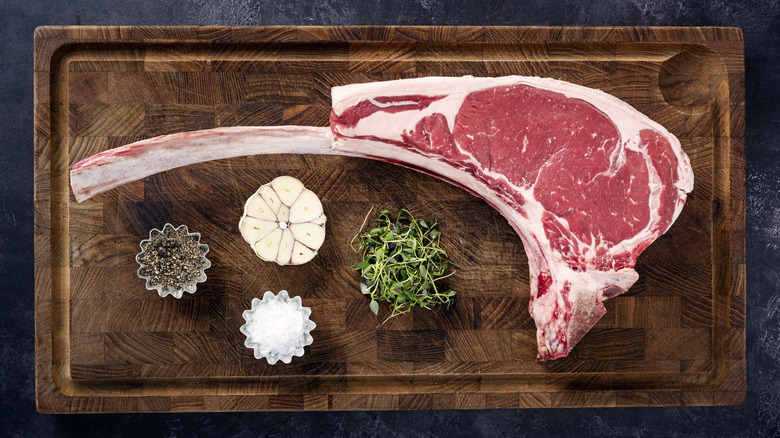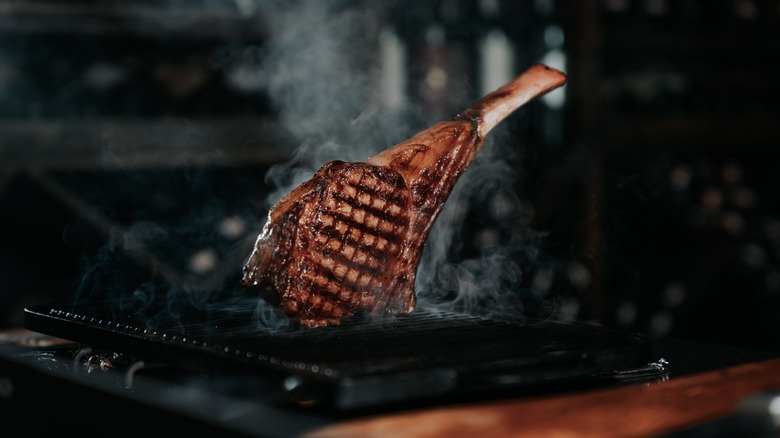What's The Best Way To Cook A Tomahawk Steak?
The tomahawk steak is the ultimate steakhouse showstopper. It's a dish you can only order if you're comfortable drawing the eyes of every other diner in the restaurant. Technically speaking, it's just a bone-in ribeye steak, but what a bone it is. The cut must have at least five inches of the rib bone attached to classify as a tomahawk steak. That bone can be up to 20 inches long, but most butchers cut it to under 10. Tomahawk steaks are butchered using the "Frenching" technique, wherein butchers carefully trim away all the meat and fat attached to the protruding bone to give it a clean appearance. This makes the cut resemble a hatchet, from which it earns the name "tomahawk."
It takes a lot of skill for a butcher to produce a perfectly frenched tomahawk steak, which is one of the reasons this steak is so rare — and pricey. If you're going to shell out the extra money that such a rare cut of steak commands, you want to make the most of your purchase and do the meat justice. You want the perfect pink interior and a nice, flavorful char on the outside, so grilling or pan-searing is perfect. However, tomahawks are exceptionally thick and risk being undercooked. To avoid this pitfall, you'll need some help from your oven.
Tomahawk steaks should be cooked in two stages
For the perfect tomahawk steak that's both tender and juicy on the inside and charred on the outside, you'll need to cook the inside and outside in separate stages. Use a grill or cast iron pan for the searing and an oven or smoker for the interior cooking. The most straightforward way to go about this would be to sear the steak in a pan, then pop it into the oven to finish cooking, but you can get an even better crust if you reverse sear the meat.
To reverse sear a steak, place it in the oven or smoker until it is just below the internal temperature you want. Then, place it on a ripping-hot grill or cast iron pan to put a nice, dark sear on all sides. Reverse searing not only helps control your steak's internal temperature better, but the oven also dries out the surface of the meat, which is what you need for the perfect, caramelized crust.
During the first stage of the reverse sear process, use a meat thermometer to track the temperature of your tomahawk steak. The benchmark for medium steak is 145 F, but when you're using the reverse sear method, you want to pull the steak out of the oven when it's 10-15 degrees shy of the target, at 130-135 degrees. Dress it how you like, but know that you can keep it simple because the tomahawk's flavor shines no matter what.
Why cook a tomahawk steak?
As you can tell, cooking a tomahawk steak requires a bit of extra effort compared to other cuts, not to mention additional patience. The thick nature of a tomahawk steak means it can take around half an hour to cook using an oven and over an hour using a smoker. This might have you wondering if tomahawk steaks are worth the time and expense, so let's address what makes them special.
The tomahawk is simply the most dramatic, eye-catching cut of meat in the world, but the best part is substance isn't sacrificed for style. Ribeye cuts are highly prized for their intense flavor and tenderness. This, along with the extra theatricality of a tomahawk steak's presentation, ups the price tag, but that only adds to the steak's sense of clout.
The meat between a cow's ribs is incredibly tender because those muscles don't work out much. A high-quality tomahawk steak will have exceptional marbling, showing off the intramuscular fat that makes ribeyes both flavorful and juicy. But be warned — this one big boy of a steak. Tomahawks come around two inches thick each, weighing from one-and-a-half to three pounds! This hefty mass is the most important thing to consider when cooking a tomahawk steak because you need that beast to cook all the way through, reaching the optimal internal temperature before the outside gets burned.


